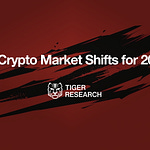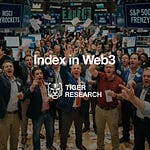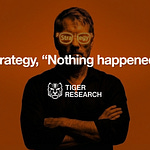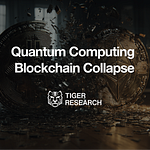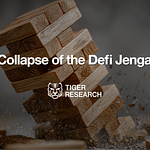Tiger Research analyzes key trends from TOKEN2049 Dubai, revealing how stablecoins emerge as essential infrastructure and the crypto industry matures from speculation to practical implementation.
TL;DR
Stablecoins emerge as core infrastructure. Once driven by narrative, stablecoins now demonstrate clear product-market fit and are establishing themselves as essential components of the digital economy.
AI expectations outpace current development. Although AI was a major theme (11% of sessions), many participants pointed to the widening gap between industry hype and actual implementation progress.
The industry is entering a phase of structural maturity. The crypto sector is transitioning from a speculative “frontier era” to one focused on infrastructure and practical use cases. The market increasingly demands proven applications and clear value propositions over conceptual innovation.
1. TOKEN2049: A Strategic Indicator of Web3 Market Direction
TOKEN2049 Dubai 2025 reaffirmed its position as a leading global crypto event, drawing over 15,000 participants from more than 160 countries. The two-day conference featured a series of high-profile presentations and discussions that reflected evolving market dynamics and emerging trends.
Having established itself as a key industry forum, TOKEN2049 serves as a barometer for the web3 market's future trajectory and narrative shifts. This report provides a structured review of TOKEN2049 Dubai 2025, organizing main stage content by core themes and offering in-depth analysis of select announcements. It also captures changes in ecosystem-wide priorities and presents strategic insights to help interpret the industry’s potential direction going forward.
2. Above the Waterline: What the Agenda Told Us
TOKEN2049 Dubai 2025 brought together a wide spectrum of blockchain discussions, reflecting the sector’s evolving priorities. Infrastructure-related topics accounted for the largest share at 15.7%, followed by AI at 11%. While the initial enthusiasm around AI agents has moderated, continued efforts to integrate AI and blockchain suggest that the theme remains structurally relevant.
Of particular note, the combined share of stablecoins (8.7%) and real-world assets (RWA, 5.5%) surpassed that of AI. This reflects growing market interest in blockchain applications with direct utility. Stablecoins, in particular, have attracted attention for their practical value in payments and settlement, while RWA has emerged as a leading category for next-generation blockchain applications.

DeFi discussions revealed a more mature perspective compared to previous years. Rather than focusing on replacing traditional finance, the emphasis shifted to how decentralized systems can complement existing institutions. This aligns with the broader industry shift toward regulatory engagement and institutional adoption.
A notable development was the growing attention toward Solana. Despite suffering major setbacks during the FTX collapse, the Solana ecosystem has rebounded and now commands more stage presence and technical discussion than Ethereum. This shift in ecosystem dynamics warrants closer examination as a potential inflection point in the Layer 1 landscape.
Overall, the main stage reflected a more grounded and pragmatic mindset. While attention-grabbing elements such as memecoins and celebrity appearances were present, they remained secondary. Core discussions centered around long-term growth drivers, including regulation, financial integration, infrastructure, and AI.
As with previous years, however, the most meaningful developments occurred off-stage. Side events and closed-door meetings revealed deeper momentum, strategic repositioning, and foundational shifts in the industry’s direction—elements that often shape the market well ahead of public narratives.
3. Below the Waterline: What Conversations Revealed
3.1. Stablecoins Are Now Infrastructure
Stablecoins have established themselves as core infrastructure in the digital economy and are now regarded as a key opportunity in the Web3 landscape. The view is gaining traction that stablecoin transactions will expand beyond on-chain activity into the real economy, potentially forming a multi-trillion-dollar market. This outlook is drawing a growing number of players into the stablecoin space.
As this perspective solidifies, industry focus has shifted from integration to gaining control over the payment layer. The ambition now extends beyond issuance, toward building end-to-end financial infrastructure. Web3 projects and institutions are intensifying efforts to secure leadership in the stablecoin stack.
Despite being in an early phase, this shift has accelerated moves by ecosystems such as Solana, Tron, and TON to establish themselves as foundational settlement platforms. Their strategies go beyond issuance, encompassing wallet development, payment infrastructure, and institutional adoption.
3.2. AI in Crypto: Exciting, but Still Experimental
A cautious tone prevailed in discussions on AI. Many participants pointed out a widening gap between market enthusiasm and the current state of development. In particular, several AI-agent projects were criticized for lacking clear use cases, reinforcing the perception that most activity in this field remains speculative.
Despite these concerns, there is sustained long-term confidence in the potential role of Web3 in the AI market. Concepts such as decentralized AI computing and open-source agent frameworks were viewed as areas with meaningful potential. These are not regarded as short-term trends but rather as long-term opportunities that may gain traction once current market noise subsides.
While AI continues to attract attention, most participants agreed that it should be approached with a long-term perspective. The focus remains on foundational experimentation rather than immediate, large-scale adoption.
3.3. Node Sales Are Booming
One notable trend at the event was the growing interest in node sales linked to physical devices. By opening up node operation—previously limited to a small group—to a broader audience, these initiatives are seen as a step toward greater decentralization and a redistribution of participation opportunities.
However, some participants viewed this trend with skepticism. They questioned whether such sales were merely retail fundraising strategies framed as ecosystem participation. Criticism focused on exaggerated reward structures, unclear token models, and a lack of meaningful network activity to justify the sales.
Despite these concerns, several projects attracted substantial capital and attention. Their long-term viability, however, remains uncertain and will be determined by actual network utility over time.
3.4. A Market Where Technology Alone No Longer Suffices
The gap between technological advancement and market adoption continues to widen. Even highly capable teams have acknowledged that sustained research alone is no longer sufficient to attract market interest. While many technically mature protocols have failed to gain user traction, simple memecoin launched through meme launchpads continue to generate consistent trading volume.
In response, industry participants are shifting their focus from research to execution. Efforts are increasingly directed toward strategic market entry, understanding liquidity flows, building exchange relationships, and designing user-friendly token models. Technical excellence remains important, but without an effective distribution strategy, the ability to generate meaningful value is limited.
Market participants increasingly express concern that short-term returns and immediate utility now take precedence over long-term innovation. In the current environment, execution outweighs potential. The market has evolved into one where technology alone cannot ensure survival.
4. Key announcements
Tether – U.S. Dollar Stablecoin Initiative: Tether CEO Paolo Ardoino announced plans for a new U.S.-compliant dollar stablecoin, distinct from USDT and targeted for release in 2025–2026. The initiative reflects ongoing regulatory engagement and includes discussions with U.S. lawmakers.
OKX – OKX Pay and Institutional Partnerships: OKX introduced OKX Pay, a self-custodial crypto payment app offering zero-fee transfers and wallet recovery via split-key technology. The firm also disclosed institutional collaborations, including work with Standard Chartered within Dubai’s VARA sandbox, and previewed planned integrations with Mastercard and Stripe.
Zodia Custody – UAE Market Entry and Regulatory Collaboration: Zodia announced its acquisition of Tungsten Custody to establish a regulated base in the UAE. It also unveiled a new custodial partnership with Bybit and jointly released a custody framework with Abu Dhabi regulators.
Mesh – Retail Crypto Payments Integration: Mesh demonstrated a new Apple Pay integration, allowing users to pay in crypto while merchants receive stablecoins. Powered by its “SmartFunding” solution, the feature is scheduled for rollout in Q2 2025 and is designed to simplify crypto payments in retail environments.
World Liberty Financial and TRON – $2B Stablecoin Investment: Abu Dhabi’s MGX fund completed a $2 billion investment into Binance using stablecoins via USD1. Following the transaction, USD1 will be natively integrated into the TRON ecosystem.
MEXC Ventures – Ecosystem Development Fund: MEXC Ventures announced a $300 million fund focused on modular chains, ZK-rollups, and self-custody solutions. The move reflects a renewed appetite for infrastructure investment following the 2022 market downturn.
Lightspark – Bitcoin-Based Payment Infrastructure: David Marcus, former PayPal executive, introduced Spark, a Bitcoin-native protocol built on the Lightning Network. The protocol aims to enable high-speed, low-cost payments, expanding Bitcoin’s utility beyond store-of-value use cases.
The announcements closely aligned with TOKEN2049’s thematic focus. Stablecoins remained a central topic, evidenced by Tether’s compliance-oriented initiative and the $2 billion stablecoin-based investment into Binance. Infrastructure development was another key theme, with firms such as OKX, Zodia, and MEXC advancing efforts around scalability, custody, and modular architecture.
Bitcoin’s evolving role was also highlighted through Lightspark’s Spark protocol, reinforcing ongoing discourse around Bitcoin’s broader functional potential. While artificial intelligence featured prominently in the speaking sessions, it was less visible among the major announcements. Instead, the emphasis remained on practical deployments in payments, compliance, and institutional access, marking a continued shift from experimentation to scaled implementation.
5. From the Frontier Era to Urbanization
This year’s conference underscored a clear shift in the crypto industry—from speculative enthusiasm to a focus on utility and infrastructure development. Three key directional themes emerged:
Stablecoins have evolved beyond narrative. They now demonstrate tangible product-market fit and are establishing themselves as foundational infrastructure for the digital economy.
AI received significant attention, but sentiment remains cautious. Many participants noted a growing gap between market excitement and the current maturity of AI development.
Dubai has cemented its role as a regulatory and capital hub for Web3. The UAE continues to lead efforts in global Web3 expansion.
Rather than introducing an entirely new wave of trends, the event highlighted the consolidation of existing narratives—particularly around AI, stablecoins, and RWA. The increasing participation of institutions and the advancement of regulatory frameworks point to a market entering a new phase of structural transformation.
The era of idealistic experimentation is giving way to one of pragmatic execution. Much like the shift from a frontier economy to an urbanized one—driven by transportation and distribution revolutions—the Web3 ecosystem is now entering a stage where sustained growth depends on infrastructure, integration, and delivery.
While the attention economy will remain a relevant factor, the market no longer rewards conceptual innovation alone. Stakeholders now expect practical applications and clearly defined value propositions. This shift signals a broader maturation across the ecosystem, paving the way for more stable, long-term development—and ushering in what can be seen as the urbanization era of Web3.
🐯 More from Tiger Research
Read more reports related to this research.Disclaimer
This report has been prepared based on materials believed to be reliable. However, we do not expressly or impliedly warrant the accuracy, completeness, and suitability of the information. We disclaim any liability for any losses arising from the use of this report or its contents. The conclusions and recommendations in this report are based on information available at the time of preparation and are subject to change without notice. All projects, estimates, forecasts, objectives, opinions, and views expressed in this report are subject to change without notice and may differ from or be contrary to the opinions of others or other organizations.
This document is for informational purposes only and should not be considered legal, business, investment, or tax advice. Any references to securities or digital assets are for illustrative purposes only and do not constitute an investment recommendation or an offer to provide investment advisory services. This material is not directed at investors or potential investors.
Terms of Usage
Tiger Research allows the fair use of its reports. ‘Fair use’ is a principle that broadly permits the use of specific content for public interest purposes, as long as it doesn't harm the commercial value of the material. If the use aligns with the purpose of fair use, the reports can be utilized without prior permission. However, when citing Tiger Research's reports, it is mandatory to 1) clearly state 'Tiger Research' as the source, 2) include the Tiger Research logo(Black/White). If the material is to be restructured and published, separate negotiations are required. Unauthorized use of the reports may result in legal action.







